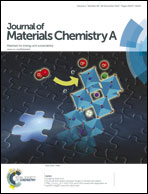Ultrasmall palladium nanoparticles supported on amine-functionalized SBA-15 efficiently catalyze hydrogen evolution from formic acid†
Abstract
The success of the so-called “hydrogen economy” for large-scale applications will ultimately depend on efficient and sustainable production, storage and distribution of hydrogen. Owing to its low toxicity, high volumetric H2 storage capacity and availability both from renewable resources (e.g., biomass) and non-renewable resources (e.g., fossil fuel feedstocks), formic acid is one of the most favorable chemical hydrogen storage media for large-scale energy storage applications. However, for FA to become a viable hydrogen storage medium, efficient catalysts that enable it to release H2 at low cost are necessary. Herein we report a facile synthetic route to amine-functionalized nanoporous silica-supported ultrasmall Pd nanoparticles (SBA-15-Amine/Pd) that are highly active catalysts for formic acid dehydrogenation, producing hydrogen at ambient temperature with a high turn-over-frequency (TOF) of 293 h−1, which is among the highest TOFs ever reported for the reaction by a heterogeneous catalyst. We also show that the material is easily recyclable multiple times, without losing its catalytic activity. So, the catalyst we developed can be expected to be part of the solutions of our sustainability challenges.


 Please wait while we load your content...
Please wait while we load your content...